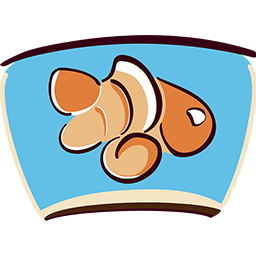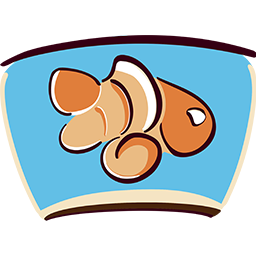Popeye
Popeye is the swelling of one or both eyes of any fish. In many cases, this is caused by either bad water conditions or fish that are fighting where one will harm the other fish's eye. Whenever you look inside and look at your inhabitants making sure that they are getting along (even during feeding or breeding times) is vital, along with making sure that the day and night cycle of the lights is subtle. If there are any bright flashing lights, loud noises, or anything that would disturb the water (or is loud enough to scare any inhabitants) then making sure to remove or limit such factors will reduce or remove any chance of any fish swimming against the glass or jumping and hitting the lids.
Identification
Popeye is very easy to identify since the only symptoms are the fish's eye, or eyes, are swollen and will bulge outwards of their normal shape and form. Only the outer portion of the eye will be exposed when this happens, and in some cases, the fish's eye will turn either a milky color, cloudy or only be swollen.
Pathology
The swelling of the fish's eye(s) is caused by tissue fluid that is leaking behind the eyeball, which when enough pressure is reached, forces the eyeball to extend outward of the fish's body. While this is happening, other bacterial infections may occur since the fluid and now extended eyeball are a perfect place for bacteria to grow (which is why many times the fish may not only act sluggish to it not wanting to hurt its eye, but may also stop eating, stay at the bottom, or single itself out from any other fish).
The root causes of this infection are normally due to poor water conditions for extended periods. This infection mostly is found within setups that are either not taken care of properly, have not fully established the nitrogen cycle at all, or is found in pond setups where the water quality is not controlled fully (not using enough filtration, not cleaning the pond's surface, never changing any water out, etc.).
Other causes can include sharp objects within the aquarium or the items that get placed into the tank. Make sure that there are no sharp objects inside of the water, which can include various decorations, intake, and output tubes to filters, and even the equipment that you use to do water changes with or catch the fish in (make sure that any nets you use feel soft to the touch and do not feel rough or hard at any location). This can include your hands if they are placed inside the water since any sharp nails or things attached to your skin can cause damage to the fish's body or eye.
Treatment and Medication
This infection is difficult to treat since there are normally three different problems that are either due to the popeye or caused by the eye being so swollen. First, there is damage to the cornea of the eye, next, there is a rather large accumulation of fluid that is behind the eye, and lastly, there is/can be secondary bacterial infections. The damage done to the cornea can be helped over time, however, this is only if there is slight/minor damage done and if the fish is given perfect water conditions and fed a rich diet of food. Swelling of the fish's eyeball will go down over time as well if the fish is quarantined, given an Epsom salt mixture of roughly 1-3 teaspoons per 5 gallons of water, and kept within perfect water conditions while being fed a rich diet of food.
Various antibacterial medicines can be used to treat any possible secondary infections, including those containing tea tree oil. If the fish's eye fully pops due to the extent of fluid, the fish will become blind on that given side of its body and will not regrow another eye. If the eye does slowly go back to its original size but is milky or cloudy, then the fish is permanently blind in that eye for the remainder of its life.
This infection can and will take several weeks before it is fully healed. During that time, it is suggested that you keep the fish within a quarantine tank and away from any other fish or inhabitants that may harm the fish even more, or harass it due to it having a hard time seeing half its body. Once the eye goes back to its normal size (or similar size to other tank mates within the setup), then treatment can stop and the fish placed back into its original water.


